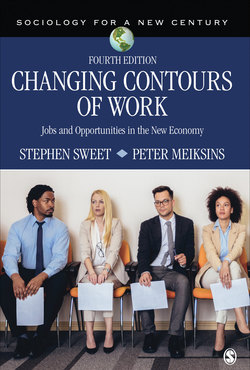Читать книгу Changing Contours of Work - Stephen Sweet - Страница 21
На сайте Литреса книга снята с продажи.
Demography and the New Labor Force
ОглавлениеSocial structure can influence what jobs are available, but it can also affect who is available to perform that work. A full appreciation of the challenges and opportunities present in the new economy requires consideration of demography and how the composition of a society affects the placement of workers into jobs and the distribution of opportunities to prepare for and obtain work (Farnesworth-Riche 2006). The paid labor force is substantially different today than it was in the mid-twentieth century or earlier. It contains a far higher percentage of women workers, and its racial and ethnic makeup is also different. We devote two chapters of this book specifically to the intersecting concerns of gender (Chapter 6) and race and ethnicity (Chapter 7); here we introduce the importance of demographic forces by considering how age structures affect the availability of jobs, the availability of workers, the need to work, and the returns received from work.
The U.S. labor force, along with those of many other developed societies, is becoming older. Americans today can expect to live twelve years longer than could those alive in 1940 and twenty-six years longer than those who were alive in 1900.5 Workers are living longer, and they are healthier when they reach ages that used to be considered “old.” This presents new opportunities and new challenges to American workers and their employers. Consider, for example, retirement. Should workers continue to stop working at sixty-five? Why? If people are living longer and staying healthy longer, perhaps work careers should be lengthened. However, older workers generally do not want jobs that demand heavy schedules (Moen 2007). More common is the desire to enter into second or third careers and to pursue work situations that focus less on earning money (although for many that remains important) and more on satisfying creative impulses or making a difference in the lives of others. Unfortunately, most employers do not offer “bridge jobs” that accommodate the possibility of the types of scaled-back employment that fit the skills and interests of these workers (Hutchens and Grace-Martin 2006, Sweet 2014).
Exhibit 1.8 Age Distributions and Predicted Distribution in the United States: 1940–2060
Source: U.S. Census Bureau.
The changing age structure of the workforce presents challenges to society as a whole, not just to employers. Exhibit 1.8 shows how the age structure of the United States has changed from 1940 to 2010 and how it is expected to change by 2060. Note that in 1940 the age structure of the United States resembled a pyramid, with most of the population in the younger age groups, with a steady attrition as one approached old age. Only a relatively small group lived beyond age seventy. In contrast, in 2010 the age pyramid looked more like a skyscraper, albeit with a bulge in the middle. This bulge is the baby boom generation, a birth cohort that is steadily aging its way into retirement years. A key structural question concerns how an aging society will provide economic support for the growing numbers of older people. Will they be required to work? Or will society continue to provide postemployment pensions for them? And, if the latter, how will that expense be financed? One can observe that this will be an especially big concern by the time the United States reaches 2060, because at that point 22% of the population will be over age sixty-five (triple the percentage that existed in 1940). But, in comparison to many other countries, the United States actually is in a relatively favorable position in respect to aging. For example, the Statistics Bureau of Japan (2012) estimated that by 2060, 40% of that country’s population will be over age sixty-five. Again, note that while this demographic composition constitutes a structural concern, its origins are linked to both culture and agency. For example, Japan is far less accepting of immigrants than the United States; immigrants tend to be young, so Japan’s approach to immigration exacerbates the consequences of native-born families’ having fewer children.
An aging population creates a pressure point because of the dependency of those outside of the labor force (the young and the old) on those in the labor force. Consider that the Social Security system, the most important source of retirement income for many Americans, is funded through taxes on currently employed workers. Those taxes become part of the general pool of Social Security revenue, which provides pensions to those who have retired. Some policy makers are concerned that if the pool of retired workers becomes larger and the pool of employed workers becomes smaller, the revenues available to fund the system will be squeezed (Weller and Wolff 2005). There is much controversy about whether this should be called a “crisis,” but there is general agreement that ways need to be found to ensure that adequate revenues will be available for the growing population of retired workers.
Demographic factors such as age, gender, and race affect virtually all aspects of the economy and workplace. Demographics play a role at the organizational level, as the experiences of ethnic minorities and women are commonly shaped by their scarcity at the top levels of organizational hierarchies. They are critically important at the community level, as neighborhoods that lack job opportunities hinder the socialization of children into the types of workers needed in the new economy. The neighborhood that Mike grew up in exerted a powerful influence on his career decisions. We return to the critical issues of aging, gender, race, education, and immigration throughout this book.
